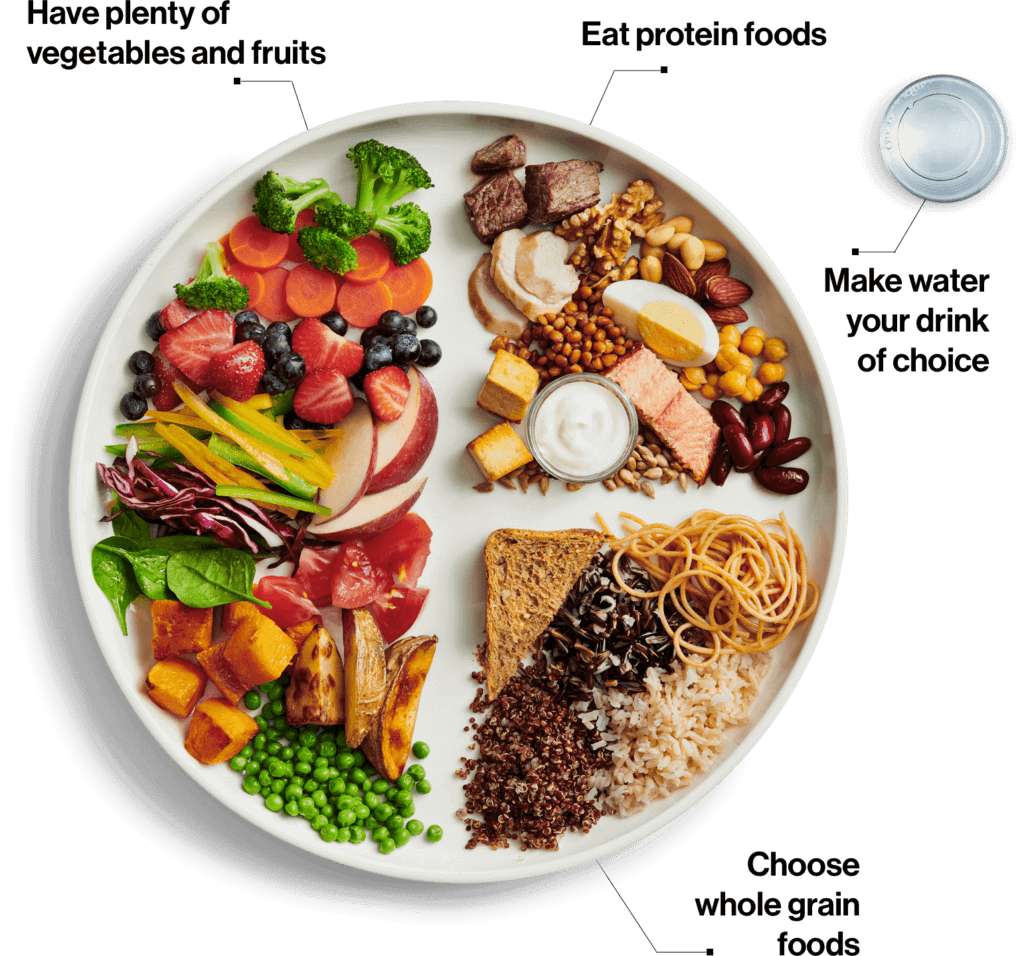You’ve likely heard in the news recently that after a long 12 years, Canada finally has a new food guide (1)!
Gone is the iconic rainbow of the 2007 guide — with serving recommendations for each of the food groups represented in the chromatic arc. Replaced instead by a single plate, half filled with vegetables and fruits, and a quarter each with whole grains and proteins.

The objective of the guidelines is to help you choose foods that improve your health, meet your nutrient needs and reduce your risk of nutrition-related diseases and conditions. It also aims to support the improvement of the Canadian food environment. Officials at Health Canada did not meet with industry representatives to discuss the food guide, and industry-commissioned reports were excluded to reduce the potential for — or the perception of— conflict of interest. That’s quite a departure from the process of creating previous renditions of the guide.
What are the new guidelines?
The guidelines themselves are intended for health professionals and policymakers, serving as a resource for developing nutrition policies, programs and educational resources for members of the Canadian population two years of age and older.The guidelines (2) are divided into 4 sections.
- The first focuses on nutritious foods that create the foundation for healthy eating. You won’t find any recommendations for portions or serving sizes of these health-promoting foods. Not many people really knew or followed these recommendations anyway. Emphasis instead is placed on proportion. Following the “half vegetables and fruits,” rule is a little more applicable to real life.
- The second part of the guidelines addresses foods that should be minimized. These include sugary drinks and confectioneries, excess sodium, alcohol, and sources of saturated fat.
- The third section dives into tips about healthy eating. It is about so much more than just the foods you eat, it is also about where, when, why and how you eat. This section emphasizes food skills to help support a more mindful approach to eating — making conscious food choices; taking the time to eat; paying attention to feelings of hunger and fullness, and avoiding distractions when eating. It also urges Canadians to cook from scratch more often and to eat together. Carefully reading of food labels, skepticism about food marketing and efforts to reduce food waste are also encouraged.
- The fourth and final section talks about implementing these guidelines and how to make healthy eating accessible and available to all Canadians.

The guidelines summarized
A summary of these guidelines can be found in the Healthy Eating Recommendations (3) page, and here is a summary of the key recommendations from Canada’s new Food Guide:
Make it a habit to eat a variety of healthy foods each day.
- Eat plenty of vegetables and fruits, whole grain foods and protein foods. Choose protein foods that come from plants more often
- Limit highly processed foods. If you choose these foods, eat them less often and in smaller amounts
- Make water your drink of choice
- Use food labels to help you compare and choose products so you can make informed choices
- Be aware that food marketing can influence your choices
Healthy eating is about more than just the foods that you eat. It is also about where, when, why and how you eat.
- Be mindful of your eating habits, take time to eat and notice when you are hungry and when you are full
- Cook more often and involve others in planning and preparing meals
- Enjoy your food, not only the taste but also the many food-related activities that go along with eating
- Eat meals with others, it’s a great way to connect and add enjoyment to your life

How to fit the guidelines into your lifestyle
To help Canadians apply the guidelines, there is a mobile-friendly web application (1). Examples of tools and resources available on this application include:- Custom information for teens, adults, parents, and older adults in a variety of settings including at home, at work, at school, on the go, grocery shopping, and eating out.
- Factsheets, videos, and recipes.
And just like physicians have unique areas of specialty, so to do nutrition professionals. Some specialize in weight concerns, eating disorders, sports nutrition or pediatrics, just to name a few. Be sure to find the right guide so you can eat well per Canada’s new food guide!



